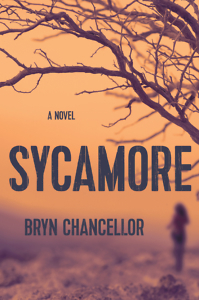Real Bones, Real Person, Not a Myth, Not a Story
In Bryn Chancellor’s Sycamore, a small town reckons with the eruption of a long-buried mystery
For longtime citizens of Sycamore, Arizona, sudden changes in the landscape are something they’ve come to expect. Flash rainstorms may flood their dry arroyos without notice. Sinkholes may open up and swallow their lakes. People they love may up and vanish, with no explanation at all. For these characters who populate Bryn Chancellor’s accomplished debut novel, Sycamore, the image of one girl has come to embody the force of instability in their lives. Seventeen-year-old Jess Winters has in fact vanished—her fate never explained or resolved—for nearly twenty years, until a new arrival in town discovers human remains outside town.
 With this disturbing news, everyone connected to the mystery of Jess’s disappearance feels the weight and force of the past suddenly pressing into the present. Told in multiple points of view, Sycamore unfolds around its many characters with powerful tenderness and page-turning suspense.
With this disturbing news, everyone connected to the mystery of Jess’s disappearance feels the weight and force of the past suddenly pressing into the present. Told in multiple points of view, Sycamore unfolds around its many characters with powerful tenderness and page-turning suspense.
A graduate of Vanderbilt University’s M.F.A. program, Chancellor won the 2014 Prairie Schooner Book Prize with her first book, the short story collection When Are You Coming Home?. In those stories, Chancellor proved she understood how the past and present could be inextricably bound in her characters’ lives. Sycamore, which also depends upon this phenomenon, displays again Chancellor’s ability to depict the mingling of past and present with deft insight and lyrical prose.
Jess—as an image, an idea, a memory, or a curiosity—haunts these characters in numerous ways, and because the novel moves between the present-day events and the time of her disappearance, 1991, we learn a great deal about how their lives have evolved over time, often reflecting their evolving image of Jess.
For her high school friend Angie, who now runs a car repair shop in Sycamore, the thought of Jess’s face comes to her as “a bright xylophone chime of a memory.” Angie experiences a rush of thoughts about “the girl who didn’t come home”—not only the lovesick crush she’d nursed for Jess, but also about what happened to her: “What if I’d seen her that night? What if she showed up on my doorstep?”
 The girl whose disappearance seemed to soak into the porous rocks of the town, a mystery lurking beneath the surface, becoming as much a legend as those bones and bikes in sinkholes.” But Angie does try to steer her runaway thoughts, reminding herself that “these were real bones, the real bones of a real person—not a myth, not a story.” Several others who knew Jess in school—like her close friend Dani and former teacher Esther—carry Jess’s memory in varied, personalized ways that reflect not only on the past but also the lives they’ve built during the intervening years.
The girl whose disappearance seemed to soak into the porous rocks of the town, a mystery lurking beneath the surface, becoming as much a legend as those bones and bikes in sinkholes.” But Angie does try to steer her runaway thoughts, reminding herself that “these were real bones, the real bones of a real person—not a myth, not a story.” Several others who knew Jess in school—like her close friend Dani and former teacher Esther—carry Jess’s memory in varied, personalized ways that reflect not only on the past but also the lives they’ve built during the intervening years.
For Maud, Jess’s mother, that image has been the source of a far larger, unending suffering. For years, Maud has perceived a ghostly version of her daughter’s voice, seen her fleeting image everywhere. And those specters are not her worst thoughts. Instead, “there were the imaginings, the speculation about what had happened: body snatched, body bloated, body burned, body floating, body bleeding, body buried alive.” No matter how Maud contemplates moving forward with her own life, the possibilities surrounding her daughter’s fate make the future nearly impossible to contemplate.
Then there is Jess herself—the actual young woman at the center of all this longing, speculation, and mythmaking. Chancellor wisely introduces us to her first. We learn the specifics of her teenage quirks and whims, complete with beginner’s poetry and the remnants of her first heartbreak. Right from the start, Jess feels actual-size, which makes the depth and reach of her effect on everyone all the more poignant.
Sycamore manages to convey the intimacy of a character study while unfolding a plot that also makes this novel difficult to put down. Chancellor draws us in right away and allows us to feel we know her characters immediately. But like the people in our own lives whom we believe we’ve got all wrapped up, the characters of Sycamore have a tendency to surprise. As the story floods rapidly into both the past and the present, Sycamore reminds us to leave open some room, always, for the unknowable.

Emily Choate holds an M.F.A. from Sarah Lawrence College. Her fiction has been published in Shenandoah, The Florida Review, Tupelo Quarterly, and The Double Dealer, and her nonfiction has appeared in Yemassee, Late Night Library, and elsewhere. She lives in Nashville, where she’s working on a novel.


